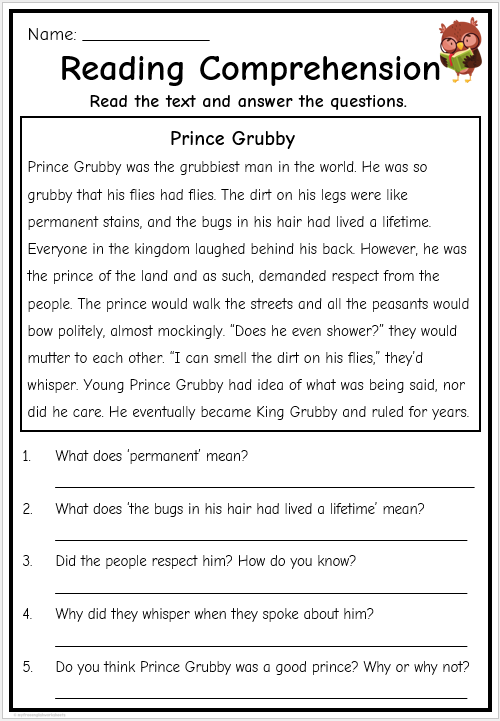Reading comprehension is a fundamental skill that unlocks a world of knowledge and understanding. It allows us to grasp the meaning of text, analyze information, and develop critical thinking abilities. In the age of information overload, strong reading comprehension is more crucial than ever.
This article delves into the power of reading comprehension worksheets and equips educators, parents, and learners with valuable insights. We’ll explore different types of worksheets, highlight their benefits, and offer tips for creating and using them effectively.
Why are Reading Comprehension Worksheets Important?
Reading comprehension worksheets go beyond simply reading words; they encourage active engagement with the text. Here’s why they are essential tools for learning:
- Improved Focus and Concentration: Worksheets with engaging exercises force readers to focus on details and specific aspects of the text, boosting their overall concentration.
- Enhanced Understanding: By answering questions, completing activities, and summarizing key points, readers solidify their understanding of the material.
- Developing Critical Thinking: Analyzing characters, motives, and themes in worksheets encourages readers to think critically and form their own interpretations.
- Building Vocabulary: Worksheets often incorporate vocabulary exercises that help readers learn new words and expand their vocabulary base.
- Self-Assessment and Practice: Completing worksheets allows learners to gauge their comprehension and identify areas that need improvement.
- Differentiation: Worksheets can be tailored to different reading levels and learning styles, ensuring everyone benefits from the practice.

Different Types of Reading Comprehension Worksheets
The beauty of reading comprehension worksheets lies in their versatility. Here are some common types to consider:
- Multiple Choice: These worksheets present readers with several answer choices for each question, requiring them to identify the most accurate option based on the text.
- True/False: Offering statements that are either true or false based on the passage helps readers distinguish between fact and opinion.
- Fill-in-the-Blank: These worksheets challenge readers to recall specific information from the text by filling in missing words or phrases.
- Matching: Matching exercises require readers to connect characters, events, or definitions with their corresponding details in the passage.
- Sequencing: These worksheets ask readers to arrange events or steps in the correct order based on the information presented.
- Open Ended: Encouraging readers to answer open-ended questions like “What is the main idea?” or “Why did the character behave this way?” promotes deeper analysis.
- Short Answer: These require readers to identify key details or summarize specific parts of the text in a few sentences.
- Graphic Organizers: Visual representations like charts, timelines, or Venn diagrams help readers organize information from the text and understand relationships between concepts.
- Creative Activities: Encouraging students to write a letter from a character’s perspective, create a comic strip based on the story, or draw a scene can make comprehension fun and engaging.
Creating Effective Reading Comprehension Worksheets
By incorporating the following tips, you can create high-quality reading comprehension worksheets:
- Target the Right Level: Match the difficulty of the worksheet to the reading level and age group of the learner. Start with simple passages for beginners and gradually increase complexity as skills develop.
- Select Engaging Texts: Choose age-appropriate and interesting reading materials that will pique the learner’s curiosity and encourage them to dive into the content.
- Variety is Key: Don’t limit yourself to a single type of question. Offer a mix of formats to keep the learner on their toes and test different aspects of comprehension.
- Focus on Key Skills: Identify the specific reading comprehension skills you want to target with each worksheet. This could be main idea identification, understanding cause and effect, or inferring information.
- Clear Instructions: Ensure the instructions for each exercise are concise and easy to understand. Aim for clarity to avoid confusion and frustration.
- Answer Keys: Provide answer keys for educators or parents who will be facilitating the learning process.
- Incorporate Graphics: Images, diagrams, and other visual elements can enhance understanding and make worksheets more engaging.
- Consider Digital Tools: Explore online platforms and interactive tools that allow you to create digital reading comprehension worksheets for a more modern learning experience.
Tips for Using Reading Comprehension Worksheets Effectively
Here are some pointers to maximize the benefits of reading comprehension worksheets:
- Pre-Reading Activities: Before diving into the worksheet, introduce the topic, activate prior knowledge through discussions, and encourage predictions about the text.
- Guided Reading: For younger students, provide scaffolding and support while working through the worksheet. Read the passage aloud, discuss unfamiliar vocabulary, and clarify any confusion.
- Independent Practice: Encourage learners to complete some sections of the worksheet independently to gauge their comprehension and build confidence.
- Discussion and Reflection: After completing the worksheet, engage students in discussions about the text. Encourage them to share their interpretations